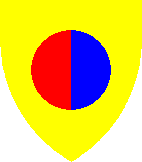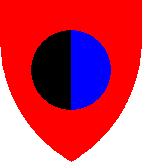
| Home | FAQs | Rules | Archives | Articles | Jobs | Links | KWHSS | OSCAR | SCA.org |
Heraldry for Non-Heralds
Section 3: Divided Charges and Fields
Before we continue, did you catch that bit of vocabulary I snuck into the last section? To review, a charge is an item placed upon the shield. A field is the background of the shield. Clear so far? Great. This next part is rarely covered by traditional heraldic texts, and is usually where many non-heralds get lost.
A neutral charge or a neutral field is a charge or a field that is equally a metal (Or, argent) and a color (gules, azure, vert, purpure, sable). As long as neither of its tinctures matches the field underneath it, a neutral charge can go onto any tinctured field. Likewise, so long as the tincture of the charge on it doesn't match either of its tinctures, a neutral field can have any tinctured charge on it.
Both charges and fields can be more than one tincture without being neutral. A charge can be split azure and gules, for example. But it cannot go onto a field that is a solid color (gules, azure, vert, purpure, sable) or a field that is split between two non-metals.
There is a special method of having both the field and the charge split along the same line, using the same color and metal. This process is called counterchanging, and flips the color and metal of the background on the charge, giving a striking effect. This is a special circumstance; since the color part of the charge only touches the metal part of the field, and vice versa, they can keep contrast while being the same tinctures.
Some examples:
| Example | Description | Acceptable? |
 |
Gules charge on an Or and azure field | Yes, because the field has both a metal and a color, and neither of them matches the charge gules. |
 |
Gules and Or charge on an azure field | Yes, because the charge has both a metal and a color, and neither of them is azure. |
 |
Gules and azure charge on an Or field | Yes, because the charge is two colors, and the field is a metal. |
 |
Or and argent charge on a sable field | Yes, because the charge is two metals, and the field is a color. |
 |
Sable and Or charge on an Or and sable field | Yes, because the charge has been counterchanged. The sable doesn't overlay the sable, and the Or doesn't overlay the Or. |
 |
Sable and azure charge on a gules field | No. This is a color (well, two colors) on a color, and breaks the rule of tincture. |
 |
Sable and azure charge on a purpure and gules field | No. This is two colors on two colors, and therefore breaks the rule of tincture. |
This is not an official publication of the Society for Creative Anachronism, Inc. nor does it seek to delineate SCA policies. The views expressed herein are those of the author, and do not necessarily reflect those of the SCA, its officers, members, or affiliates. All contents ©2009-2013, Kevin Rhodes. Please contact the author before reproduction.
The heraldry.sca.org site is copyright 1995-2024 Society for Creative Anachronism, Inc. The copyright of certain portions of heraldry.sca.org are retained by the original contributors as noted.
External links are not part of the heraldry.sca.org web site. Inclusion of a page or site here is neither implicit nor explicit endorsement of the site. Further, SCA, Inc. is not responsible for content outside of heraldry.sca.org. For information on how SCA uses collected and submitted data, please see the Privacy Policy.
Paper texture used with permission from GRSites.com.